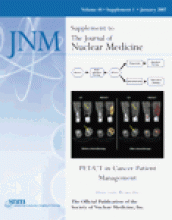
Lalitha K. Shankar
Combined 18F-FDG PET/CT is rapidly becoming a mainstay in the management of many types of cancer both in clinical practice and in clinical trials, serving as a tool for improving patient management as well as for accelerating drug development. This modality makes possible the facile, noninvasive evaluation of both metabolic and anatomic information—a tremendous advantage over other currently available diagnostic tools. It brings closer the possibility of personalized care in cancer management.

Daniel C. Sullivan
This supplement to The Journal of Nuclear Medicine brings together a collection of articles that discuss the current state of knowledge on the use of 18F-FDG PET/CT in the care of cancer patients. The authors discuss its role in the continuum of cancer care—a role encompassing the broad spectrum of screening, diagnosis, initial treatment planning, treatment monitoring, and detection of early recurrence.
The first prototype PET/CT scanner was developed by David Townsend and colleagues, with support by a grant from the National Cancer Institute. Within a few years after his successful demonstration of feasibility, all major manufacturers of imaging devices were offering combined PET/CT scanners for sale. The rapid clinical adoption of these devices is a testimony to the perceived value of combined anatomic and functional information in clinical oncology.
As with the advent of any significant—indeed, transformational—technology in patient management, the growth of 18F-FDG PET/CT into a prominent tool in cancer care has many implications, not only in the realm of clinical care but also in the larger framework of societal issues. For instance, the potential of this technology in future algorithms, be they cancer screening, diagnosis, or treatment monitoring, has to be considered in the context of appropriate cohorts, scientific rationale, and the associated financial, legal, and radiation burdens.
There is a growing body of literature in this new arena, and there is much more to be done. The National Cancer Institute hopes to work with the academic community, pharmaceutical companies, and device manufacturers in helping to plan and enable additional evaluations of the role of 18F-FDG PET/CT in various aspects of the care of cancer patients.
Footnotes
-
COPYRIGHT © 2007 by the Society of Nuclear Medicine, Inc.







